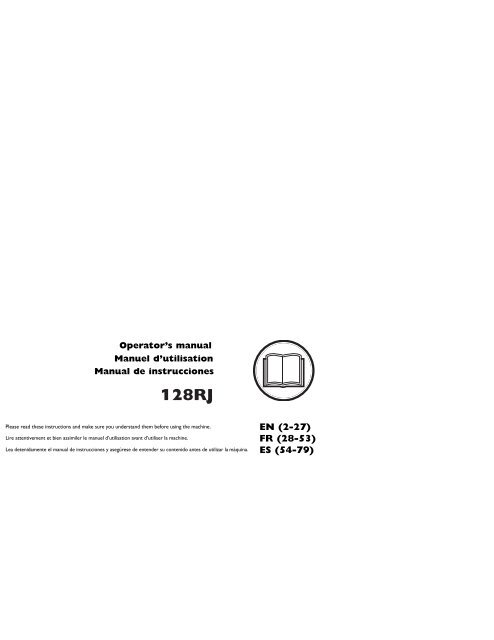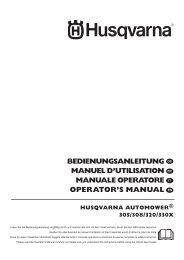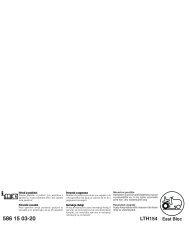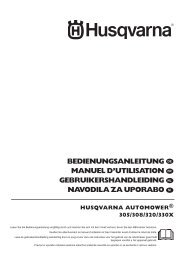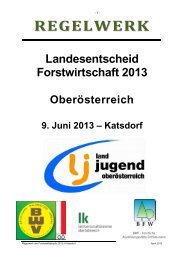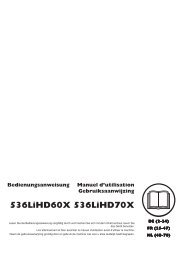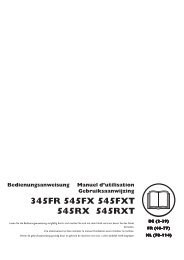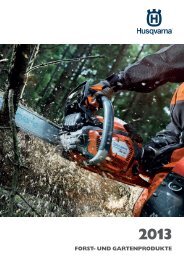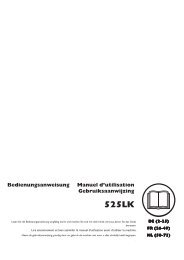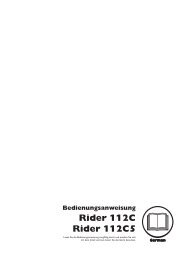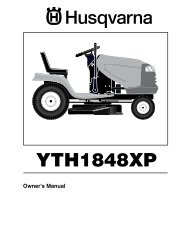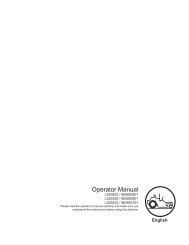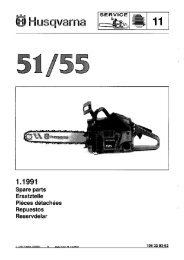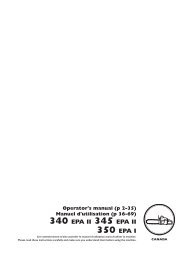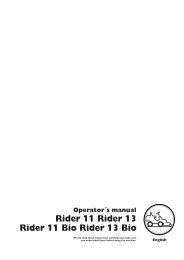OM, 128 RJ, 2009-06 - Husqvarna
OM, 128 RJ, 2009-06 - Husqvarna
OM, 128 RJ, 2009-06 - Husqvarna
Create successful ePaper yourself
Turn your PDF publications into a flip-book with our unique Google optimized e-Paper software.
EN (2-27)<br />
FR (28-53)<br />
ES (54-79)
SYMBOL EXPLANATION<br />
Symbols<br />
WARNING: Clearing saws, brushcutters<br />
and trimmers can be dangerous!<br />
Careless or incorrect use<br />
can result in serious or fatal<br />
injury to the operator or others.<br />
Please read the operator’s manual<br />
carefully and make sure you<br />
understand the instructions<br />
before using the machine.<br />
Always wear:<br />
S A protective helmet where there<br />
is a risk of falling objects<br />
S Hearing protection<br />
S Approved eye protection<br />
This product is in accordance<br />
with applicable EC directives.<br />
Noise emission to the<br />
environment according to the<br />
European Community’s<br />
Directive. The machine’s<br />
emission is specified in the<br />
Technical data section and<br />
on label.<br />
Sound pressure level at<br />
7,5 metres.<br />
Max. speed of output shaft, rpm<br />
Beware of thrown objects and<br />
ricochets.<br />
The operator of the machine<br />
shall ensure, while working,<br />
that no persons or animals<br />
come closer than 15 metres.<br />
Machines fitted with grass blades<br />
can be thrown violently to the side<br />
when the blade comes into contact<br />
with a fixed object. The blade is<br />
capable of amputating an arm or<br />
leg. Always keep people and<br />
animals at least 15 metres from<br />
the machine.<br />
Arrows which show limits for<br />
handle mounting.<br />
Use unleaded or quality leaded<br />
petrol and two -stroke oil<br />
mixed at a ratio of 2% (1:50).<br />
Other symbols/decals on the machine<br />
refer to special certification requirements<br />
for certain markets.<br />
Stop the engine by pushing<br />
and holding the stop switch<br />
in the STOP position. CAUTION!<br />
The stop switch automatically<br />
returns to the start position.<br />
In order to prevent unintentional<br />
starting, the spark plug cap must be<br />
removed from the spark plug when<br />
assembling, checking and/or<br />
performing maintenance.<br />
Regular cleaning is required.<br />
Always wear approved protective<br />
gloves.<br />
Use anti -slip and stable boots.<br />
Visual check.<br />
Approved eye protection must<br />
always be used.<br />
Only use non -metallic, flexible<br />
cutting attachments, i.e. trimmer<br />
heads with trimmer line.<br />
545196786 Rev. 2 4/30/09<br />
English---2
Contents<br />
KEY TO SYMBOLS<br />
Symbols ......................... 2<br />
CONTENTS<br />
Contents ........................ 3<br />
Note the following before starting .... 3<br />
WHAT IS WHAT?<br />
What is what? ................... 4<br />
GENERAL SAFETY PRECAUTIONS<br />
Important ........................ 5<br />
Personal protective equipment ...... 5<br />
Machine’s safety equipment ........ 6<br />
Cutting equipment ................. 8<br />
ASSEMBLY<br />
Fitting the handlebar ............... 10<br />
Fitting the harness and harness clamp 10<br />
Fitting blades and trimmer heads .... 11<br />
Fitting a blade guard, grass blade and<br />
grass cutter ...................... 11<br />
Fitting the trimmer guard and<br />
trimmer head ..................... 12<br />
FUEL HANDLING<br />
Fuel safety ....................... 13<br />
Fuel ............................ 13<br />
Fuelling ......................... 14<br />
STARTING AND STOPPING<br />
Check before starting .............. 15<br />
Starting and stopping .............. 15<br />
WORKING TECHNIQUES<br />
General working instructions ........ 17<br />
MAINTENANCE<br />
Carburetor ....................... 20<br />
Muffler .......................... 20<br />
Spark plug ....................... 21<br />
Air filter .......................... 21<br />
Bevel gear ....................... 21<br />
Sharpening grass cutters and grass<br />
blades .......................... 22<br />
Maintenance schedule ............. 23<br />
TECHNICAL DATA<br />
Technical data .................... 24<br />
EC -declaration of conformity<br />
(Applies to Europe only) ............ 25<br />
CONTENTS<br />
Note the following before<br />
starting:<br />
Please read the operator’s manual carefully.<br />
WARNING: Under no circumstances<br />
may the design of the<br />
machine be modified without the<br />
permission of the manufacturer.<br />
Always use genuine accessories.<br />
Non -authorized modifications<br />
and/or accessories can result<br />
in serious personal injury or the<br />
death of the operator or others.<br />
WARNING: A clearing saw,<br />
brushcutter or trimmer can be<br />
dangerous if used incorrectly or<br />
carelessly, and can cause serious<br />
or fatal injury to the operator or<br />
others. It is extremely important<br />
that you read and understand the<br />
contents of this operator’s manual.<br />
WARNING: Long -term exposure<br />
to noise can result in permanent<br />
hearing impairment. So always use<br />
approved hearing protection.<br />
<strong>Husqvarna</strong> AB has a policy of continuous<br />
product development and therefore<br />
reserves the right to modify the design and<br />
appearance of products without prior<br />
notice.<br />
545196786 Rev. 2 4/30/09<br />
English---3
WHAT IS WHAT?<br />
1<br />
2<br />
3<br />
5<br />
6<br />
4<br />
10<br />
8<br />
9 11<br />
12<br />
18<br />
19<br />
20<br />
28<br />
17<br />
7<br />
16<br />
14<br />
15<br />
13<br />
1<br />
22<br />
21<br />
23<br />
4<br />
21<br />
25<br />
27<br />
26<br />
4<br />
24<br />
What is what?<br />
1. Blade 16. Air filter cover<br />
2. Grease filler cap 17. Handle adjustment<br />
3. Bevel gear 18. Locking nut<br />
4. Cutting attachment guard 19. Support flange<br />
5. Shaft 20. Support cup<br />
6. Loop handle 21. Drive disc<br />
7. Throttle control 22. Trimmer head<br />
8. Stop switch 23. Socket spanner<br />
9. Throttle lock -out 24. Transport guard<br />
10. Harness clamp 25. Hex wrench<br />
11. Cylinder cover 26. Locking pin<br />
12. Starter handle 27. Harness<br />
13. Fuel tank 28. J -handle<br />
14. Choke control 29. Operator’s manual<br />
15. Primer bulb<br />
29<br />
545196786 Rev. 2 4/30/09<br />
English---4
GENERAL SAFETY PRECAUTIONS<br />
Personal protective equipment<br />
Important<br />
IMPORTANT! The machine is only designed<br />
for trimming grass, grass clearing and/or<br />
forestry clearing.<br />
The only accessories you can operate with<br />
this engine unit are the cutting attachments we<br />
recommend in the section on Technical data.<br />
Never use the machine if you are tired, if you<br />
have drunk alcohol, or if you are taking medication<br />
that could affect your vision, your judgement<br />
or your co -ordination.<br />
Never use the machine in extreme weather<br />
conditions such as severe cold, very hot and/<br />
or humid climates.<br />
Wear personal protective equipment. See instructions<br />
under the heading Personal protective<br />
equipment.<br />
Never use a machine that has been modified<br />
in any way from its original specification.<br />
Never use a machine that is faulty. Carry out<br />
the checks, maintenance and service instructions<br />
described in this manual. Some maintenance<br />
and service measures must be carried<br />
out by trained and qualified specialists. See<br />
instructions under the heading Maintenance.<br />
All covers and guards must be fitted before<br />
starting. Make sure the spark plug cap and<br />
lead are not damaged. Otherwise you could<br />
get an electric shock.<br />
The machine operator must ensure that no<br />
people or animals come closer than 15 metres<br />
while working. When several operators are<br />
working in the same area, the safety distance<br />
should be at least 15 metres.<br />
IMPORTANT! A clearing saw, brushcutter<br />
or trimmer can be dangerous if used incorrectly<br />
or carelessly, and can cause serious<br />
or fatal injury to the operator or others. It is<br />
extremely important that you read and understand<br />
the contents of this operator’s<br />
manual. You must use approved personal<br />
protective equipment whenever you use the<br />
machine. Personal protective equipment<br />
cannot eliminate the risk of injury but it will<br />
reduce the degree of injury if an accident<br />
does happen. Ask your dealer for help in<br />
choosing the right equipment.<br />
WARNING: Listen out for warning<br />
signals or shouts when you are<br />
wearing hearing protection. Always<br />
remove your hearing protection as<br />
soon as the engine stops.<br />
HELMET<br />
A helmet should be worn if the brush being<br />
cleared is taller than 2 metres.<br />
HEARING PROTECTION<br />
Wear hearing protection that provides<br />
adequate noise reduction.<br />
WARNING: Using an incorrect<br />
cutting attachment or an incorrectly<br />
filed blade can increase the risk of<br />
accidents.<br />
WARNING: Never allow children<br />
to use or be in the vicinity of the<br />
machine. As the machine is equipped<br />
withaspring-loadedstopswitchand<br />
can be started by low speed and<br />
force on the starter handle, even<br />
small children under some circumstances<br />
can produce the force necessary<br />
to start the machine. This can<br />
mean a risk of serious personal injury.<br />
Therefore remove the spark plug<br />
cap when the machine is not under<br />
close supervision.<br />
EYE PROTECTION<br />
Always wear approved eye protection. If<br />
you use a visor then you must also wear<br />
approved protective goggles. Approved<br />
protective goggles must comply with EN<br />
166 in EU countries.<br />
GLOVES<br />
Gloves should be worn when necessary,<br />
e.g., when fitting cutting attachments.<br />
BOOTS<br />
Wear anti -slip and stable boots.<br />
545196786 Rev. 2 4/30/09<br />
English---5
GENERAL SAFETY PRECAUTIONS<br />
CLOTHING<br />
Wear clothes made of a strong fabric and<br />
avoid loose clothing that can catch on<br />
shrubs and branches. Always wear heavy,<br />
long pants. Do not wear jewelry, shorts<br />
sandals or go barefoot. Secure hair so it is<br />
above shoulder level.<br />
FIRST AID KIT<br />
A first aid kit should be carried by operators<br />
of clearing saws, brushcutters or trimmers.<br />
A<br />
B<br />
Make sure the throttle control is locked at<br />
the idle setting when the throttle lock -out is<br />
released.<br />
Machine’s safety equipment<br />
This section describes the machine’s safety<br />
equipment, its purpose, and how checks<br />
and maintenance should be carried out to<br />
ensure that it operates correctly. See the<br />
“What is what” section to locate where this<br />
equipment is positioned on your machine.<br />
The life span of the machine can be reduced<br />
and the risk of accidents can increase<br />
if machine maintenance is not carried<br />
out correctly and if service and/or repairs<br />
are not carried out professionally. If<br />
you need further information please contact<br />
your nearest service workshop.<br />
IMPORTANT! All servicing and repair work<br />
on the machine requires special training. This<br />
is especially true of the machine’s safety<br />
equipment. If your machine fails any of the<br />
checks described below you must contact<br />
your service agent. When you buy any of our<br />
products we guarantee the availability of professional<br />
repairs and service. If the retailer<br />
who sells your machine is not a servicing<br />
dealer, ask him for the address of your nearest<br />
service agent.<br />
WARNING: Never use a machine<br />
that has faulty safety equipment!<br />
Follow the control, maintenance<br />
and service instructions described<br />
in this section. If your machine fails<br />
any of these checks contact your<br />
service agent to get it repaired.<br />
Throttle lock -out<br />
The throttle lock -out is designed to prevent<br />
accidental operation of the throttle control.<br />
When you press the lock -out (A) (i.e. when<br />
you grasp the handle) it releases the<br />
throttle control (B). When you release the<br />
handle, the throttle control and the throttle<br />
lock -out both move back to their original<br />
positions. This movement is controlled by<br />
two independent return springs. This arrangement<br />
means that the throttle control is<br />
automatically locked at the idle setting.<br />
545196786 Rev. 2 4/30/09<br />
Press the throttle lock -out and make sure it<br />
returns to its original position when you release<br />
it.<br />
Check that the throttle control and throttle<br />
lock -out move freely and that the return<br />
springs work properly.<br />
See instructions under the heading Start.<br />
Start the machine and apply full throttle.<br />
Release the throttle and check that the<br />
cutting attachment stops and remains at a<br />
standstill. If the cutting attachment rotates<br />
with the throttle in the idle position then the<br />
carburettor idle setting must be checked.<br />
See instructions under the heading<br />
Maintenance.<br />
English---6
GENERAL SAFETY PRECAUTIONS<br />
Stop switch<br />
Make sure the engine stops when you push<br />
and hold the stop switch.<br />
Muffler<br />
Cutting attachment guard<br />
The muffler is designed to reduce the noise<br />
level and to direct the exhaust gases away<br />
from the operator.<br />
CAUTION! Muffler is fitted with a catalytic<br />
convertic designed to reduce harmful exhaust<br />
gases.<br />
This guard is intended to prevent loose<br />
objects from being thrown towards the<br />
operator. The guard also protects the<br />
operator from accidental contact with the<br />
cutting attachment.<br />
In countries that have a warm and dry<br />
climate there is a significant risk of fire.<br />
We therefore fit certain mufflers with a spark<br />
arrestor mesh. Check whether the muffler<br />
on your machine is fitted with this kind of<br />
mesh.<br />
Muffler bolts<br />
Spark arrestor mesh<br />
Check that the guard is undamaged and not<br />
cracked. Replace the guard if it has been<br />
exposed to impact or is cracked.<br />
Always use the recommended guard for the<br />
cutting attachment you are using. See the<br />
“Technical data” section.<br />
WARNING: Never use a cutting<br />
attachment without an approved<br />
guard. See the section on “Technical<br />
data”. If an incorrect or faulty guard<br />
is fitted this can cause serious<br />
personal injury.<br />
Use of incorrectly wound trimmer line or an<br />
incorrect cutting attachment increases the<br />
level of vibration.<br />
WARNING: Overexposure to<br />
vibration can lead to circulatory<br />
damage or nerve damage in people<br />
whohaveimpairedcirculation.<br />
Contact your doctor if you experience<br />
symptoms of overexposure to<br />
vibration. Such symptoms include<br />
numbness, loss of feeling, tingling,<br />
pricking, pain, loss of strength,<br />
changes in skin color or condition.<br />
These symptoms normally appear<br />
in the fingers, hands or wrists. The<br />
risk increases at low temperatures.<br />
545196786 Rev. 2 4/30/09<br />
For mufflers, it is very important that you<br />
follow the instructions on checking, maintaining,<br />
and servicing your machine.<br />
Never use a machine that has a faulty<br />
muffler.<br />
Regularly check that the muffler is securely<br />
attached to the machine.<br />
WARNING: Mufflers fitted with<br />
catalytic converters get very hot<br />
duringuseandremainsoforsome<br />
time after stopping. This also applies<br />
at idle speed. Contact can result<br />
in burns to the skin. Remember<br />
theriskoffire!<br />
WARNING: The inside of the<br />
muffler contain chemicals that may<br />
be carcinogenic. Avoid contact with<br />
these elements in the event of a<br />
damaged muffler.<br />
English---7
GENERAL SAFETY PRECAUTIONS<br />
WARNING: Bear in mind that:<br />
Engine exhaust fumes contain carbon<br />
monoxide, which can cause<br />
carbon monoxide poisoning. For<br />
this reason you should not start or<br />
run the machine indoors, or anywhere<br />
that is poorly ventilated.<br />
The exhaust fumes from the engine<br />
are hot and may contain sparks<br />
which can start a fire. Never start<br />
the machine indoors or near combustible<br />
material!<br />
Locking nut<br />
A locking nut is used to secure some types<br />
of cutting attachment.<br />
When fitting, tighten the nut in the opposite<br />
direction to the direction of rotation of the<br />
cutting attachment. To remove it, undo the<br />
nut in the same direction as the cutting attachment<br />
rotates. (CAUTION! The nut has<br />
a left -hand thread.) Tighten the nut using<br />
the socket spanner.<br />
IMPORTANT!<br />
Only use cutting attachments with the guards<br />
we recommend! See the section on<br />
“Technical data”.<br />
Refer to the instructions for the cutting attachment<br />
to check the correct way to load the<br />
trimmer line and the correct line diameter.<br />
Keep the teeth of the blade correctly sharpened!<br />
Follow our recommendations. Also refer<br />
to the instructions on the blade packaging.<br />
Maintain the correct blade setting! Follow our<br />
instructions and use the recommended file<br />
gauge.<br />
WARNING: Always stop the engine<br />
before doing any work on the<br />
cutting attachment. This continues<br />
to rotate even after the throttle has<br />
been released. Ensure that the<br />
cutting attachment has stopped<br />
completely and disconnect the<br />
lead from the spark plug before<br />
you start to work on it.<br />
WARNING:<br />
Using an incorrect<br />
cutting attachment or an incorrectly<br />
sharpened blade increases the<br />
risk of kickback.<br />
Cutting equipment<br />
Grass blades and grass cutters are intended<br />
for cutting coarse grass.<br />
A trimmer head is intended for trimming<br />
grass.<br />
The nylon lining inside the locking nut must<br />
not be so worn that you can turn it by<br />
hand. The lining should offer a resistance<br />
of at least 1.5 Nm. The nut should be replaced<br />
after it has been put on approx. 10<br />
times.<br />
Cutting equipment<br />
This section describes how to choose and<br />
maintain your cutting equipment in order to:<br />
S Reduce the risk of blade thrust.<br />
S Obtain maximum cutting performance.<br />
S Extend the life of cutting equipment.<br />
General rules<br />
Only use cutting attachments with the<br />
guards we recommend! See the section on<br />
Technical data.<br />
545196786 Rev. 2 4/30/09<br />
Keep the teeth of the blade correctly sharpened!<br />
Follow our instructions and use the<br />
recommended file gauge. An incorrectly<br />
sharpened or damaged blade increases the<br />
risk of accidents.<br />
English---8
GENERAL SAFETY PRECAUTIONS<br />
Trimmer head<br />
IMPORTANT!<br />
Always ensure the trimmer line is wound<br />
tightly and evenly around the drum, otherwise<br />
the machine will generate harmful<br />
vibration.<br />
Check the cutting attachment for damage<br />
or cracks. A damaged cutting attachment<br />
should always be replaced.<br />
S Only use the recommended cutting attachments.<br />
See the section on “Technical<br />
data”.<br />
Sharpening grass cutters and<br />
grass blades<br />
S See the cutting attachment packaging for<br />
correct sharpening instructions. Sharpen<br />
blades and cutters using a single -cut flat file.<br />
S Sharpen all edges equally to maintain the<br />
balance of the blade.<br />
S Smaller machines generally require small<br />
trimmer heads and vice versa. This is because<br />
when clearing using trimmer line<br />
the engine must throw out the trimmer<br />
line radially from the trimmer head and<br />
overcome the resistance of the grass<br />
being cleared.<br />
S The length of the trimmer line is also important.<br />
A longer trimmer line requires<br />
greater engine power than a shorter<br />
trimmer line of the same diameter.<br />
S Make sure that the cutter on the trimmer<br />
guard is intact. This is used to cut the<br />
trimmer line to the correct length.<br />
S To increase the life of the trimmer line it<br />
can be soaked in water for a couple of<br />
days. This will make the line tougher so<br />
that it lasts longer.<br />
WARNING:<br />
Always discard a<br />
blade that is bent, twisted, cracked,<br />
broken or damaged in any other<br />
way. Never attempt to straighten<br />
a twisted blade so that it can be reused.<br />
Only use original blades of<br />
the specified type.<br />
545196786 Rev. 2 4/30/09<br />
English---9
NOTE: Make sure unit is assembled correctly<br />
as shown in this manual.<br />
Fitting the loop handle<br />
S Position the handle on the shaft. Note that<br />
the handle must be mounted between the<br />
two arrows on the shaft.<br />
ASSEMBLY<br />
S Fit the screw, securing plate and wing nut<br />
as shown in the diagram.<br />
S Make a final adjustment of the J -handle<br />
to a comfortable working position.<br />
Tighten the wing nut.<br />
WARNING:<br />
Only grass blades/<br />
grass cutters or trimmer heads/plastic<br />
blades may be used when the<br />
J -handle is fitted. Saw blades must<br />
never be used with the J -handle.<br />
Fitting the harness<br />
S Insert two screws into the screw holes.<br />
S Secure harness clamp by tightening<br />
screws with a hex wrench.<br />
Adjusting the harness<br />
S Insert your right arm and head through<br />
the harness and allow it to rest on your<br />
left shoulder. Make sure the harness<br />
hook is to the right side of your waist.<br />
NOTE: A one-half twist is built in the harness<br />
to allow the harness to rest flat on the<br />
shoulder.<br />
S Adjust the harness, allowing the hook to<br />
be about 15 cm below the waist.<br />
S Fasten the harness to the harness clamp<br />
on the shaft and lift the unit to the operating<br />
position.<br />
S Put on the harness. Now make a final<br />
adjustment so that the unit is in a comfortable<br />
working position when it hangs<br />
from the harness.<br />
NOTE: It may be necessary to relocate<br />
the harness clamp on the shaft for proper<br />
balancing of unit.<br />
WARNING:<br />
When using a<br />
brushcutter, it must always be<br />
hooked securely to the harness.<br />
Otherwise, you will be unable to<br />
control the brushcutter safely.<br />
This can result in injury to yourself<br />
or others.<br />
Proper harness and handlebar adjustments<br />
must be made with the engine completely<br />
stopped before using unit.<br />
Fitting the harness clamp<br />
S Place the upper harness clamp over the<br />
shaft and position the lower harness<br />
clamp under the shaft. Align the upper<br />
and lower clamp screw holes. Clamp<br />
must be fitted above the arrow on the<br />
shaft (see illustration).<br />
545196786 Rev. 2 4/30/09<br />
Correct height<br />
Adjust the harness so that the cutting attachment<br />
is parallel to the ground.<br />
English---10
Correct balance<br />
Let the cutting attachment rest lightly on<br />
the ground. If you use a grass blade, it<br />
should balance about 10 cm above the<br />
ground to prevent contact with stones and<br />
the like. Adjust the position of the harness<br />
clamp to balance the unit correctly.<br />
ASSEMBLY<br />
Fitting a blade guard, grass<br />
blade and grass cutter<br />
Fitting blades and trimmer<br />
heads<br />
S When fitting the cutting attachment it is<br />
extremely important that the raised section<br />
on the drive disc/support flange engages<br />
correctly in the centre hole of the cutting<br />
attachment. If the cutting attachment is<br />
fitted incorrectly it can result in serious and/<br />
or fatal personal injury.<br />
WARNING:<br />
Never use a cutting<br />
attachment without an approved<br />
guard. See the section on Technical<br />
data. If an incorrect or faulty<br />
guard is fitted this can cause serious<br />
personal injury.<br />
S Hook the blade guard/combination guard<br />
(A) onto the fitting on the shaft and secure<br />
with the bolt.<br />
CAUTION! Use the recommended blade<br />
guard. See the Technical data section.<br />
S Fit the drive disc (B) on the output shaft.<br />
S Turn the blade shaft until one of the<br />
holes in the drive disc aligns with the<br />
corresponding hole in the gear housing.<br />
S Insert the locking pin (C) in the hole to<br />
lock the shaft.<br />
S Place the blade (D), support cup (E) and<br />
support flange (F) on the output shaft.<br />
S Fit the nut (G). The nut must be tightened<br />
to a torque of 35 -50 Nm (3.5 -5<br />
kpm). Use the socket spanner in the tool<br />
kit. Hold the shaft of the spanner as<br />
close to the blade guard as possible. To<br />
tighten the nut, turn the spanner in the<br />
opposite direction to the direction of rotation<br />
(CAUTION! left -hand thread).<br />
545196786 Rev. 2 4/30/09<br />
English---11
Fitting the trimmer guard and<br />
trimmer head<br />
ASSEMBLY<br />
S Fit the correct trimmer guard (A) for use<br />
with the trimmer head. Hook the trimmer<br />
guard/combination guard onto the fitting<br />
on the shaft and secure with the bolt (D).<br />
D<br />
B<br />
C<br />
A<br />
A<br />
S Fit the drive disc (B) on the output shaft.<br />
S Turn the shaft until one of the holes in the<br />
drive disc aligns with the corresponding<br />
hole in the gear housing.<br />
S Insert the locking pin (C) in the hole to<br />
lock the shaft.<br />
S Screw on the trimmer head (H) in the opposite<br />
direction to the direction of rotation.<br />
H<br />
S To dismantle, follow the instructions in<br />
the reverse order.<br />
545196786 Rev. 2 4/30/09<br />
English---12
FUEL HANDLING<br />
Fuel safety<br />
Never start the machine:<br />
1. If you have spilled fuel on it. Wipe off the<br />
spillage and allow remaining fuel to evaporate.<br />
2. If you have spilled fuel on yourself or your<br />
clothes, change your clothes. Wash any<br />
part of your body that has come in contact<br />
with fuel. Use soap and water.<br />
3. If the machine is leaking fuel. Check regularly<br />
for leaks from the fuel cap and fuel<br />
lines.<br />
Transport and storage<br />
S Store and transport the machine and fuel<br />
so that there is no risk of any leakage or<br />
fumes coming into contact with sparks or<br />
naked flames, for example, from electrical<br />
machinery, electric motors, electrical<br />
relays/switches or boilers.<br />
S When storing and transporting fuel always<br />
use approved containers intended<br />
for this purpose.<br />
S When storing the machine for long periods<br />
the fuel tank must be emptied. Contact<br />
your local petrol station to find out<br />
where to dispose of excess fuel.<br />
S Ensure the machine is cleaned and that<br />
a complete service is carried out before<br />
long -term storage.<br />
S The transport guard must always be<br />
fitted to the cutting attachment when the<br />
machine is being transported or in storage.<br />
S In order to prevent unintentional starting<br />
of the engine, the spark plug cap must<br />
always be removed during long -term<br />
storage, if the machine is not under<br />
close supervision and when performing<br />
all service measures.<br />
WARNING: Take care when handling<br />
fuel. Bear in mind the risk of<br />
fire, explosion and inhaling fumes.<br />
Fuel<br />
CAUTION! The machine is equipped with a<br />
two -stroke engine and must always be run<br />
using a mixture of petrol and two-stroke<br />
engine oil. It is important to accurately measure<br />
the amount of oil to be mixed to ensure<br />
that the correct mixture is obtained. When<br />
mixing small amounts of fuel, even small<br />
inaccuracies can drastically affect the ratio<br />
of the mixture.<br />
Petrol<br />
CAUTION! Always use a good quality petrol/oil<br />
mixture (at least 90 octane).<br />
Use low -emission petrol, also known as<br />
alkylate petrol, if it is available.<br />
S The lowest octane recommended is 90.<br />
If you run the engine on a lower octane<br />
than 90, it can result in knocking. This<br />
gives rise to a high engine temperature,<br />
which can result in serious engine damage.<br />
S When working at continuous high revs, a<br />
higher octane rating is recommended.<br />
Two -stroke oil<br />
S For best results and performance, use<br />
HUSQVARNA two -stroke oil, which is<br />
specially formulated for our two -stroke<br />
engines. Mixture 1:50 (2%).<br />
S If HUSQVARNA two-stroke oil is not available,<br />
you may use another two-stroke oil of<br />
good quality that is intended for air cooled<br />
engines. Contact your dealer when selecting<br />
an oil. Mixing ratio 1:33 (3%).<br />
S Never use two -stroke oil intended for<br />
water -cooled outboard engines,<br />
sometimes referred to as outboard oil.<br />
S Never use oil intended for four -stroke<br />
engines.<br />
Petrol,<br />
litre<br />
Two -stroke oil, litre<br />
2% (1:50) 3% (1:33)<br />
5 0,10 0,15<br />
10 0,20 0,30<br />
15 0,30 0,45<br />
20 0,40 0,60<br />
WARNING: Fuel and fuel fumes<br />
are highly inflammable and can<br />
cause serious injury when inhaled<br />
or allowed to come in contact with<br />
the skin. For this reason observe<br />
caution when handling fuel and<br />
make sure there is adequate ventilation.<br />
545196786 Rev. 2 4/30/09<br />
English---13
Mixing<br />
S Always mix the petrol and oil in a clean<br />
container intended for fuel.<br />
S Always start by flling half the amount of the<br />
petrol to be used. Then add the entire<br />
amount of oil. Mix (shake) the fuel mixture.<br />
Add the remaining amount of petrol.<br />
S Mix (shake) the fuel mixture thoroughly<br />
before filling the machine’s fuel tank.<br />
S Do not mix more than one month’s supply<br />
of fuel at a time.<br />
S If the machine is not used for some time,<br />
the fuel tank should be emptied and<br />
cleaned.<br />
WARNING: The catalytic converter<br />
muffler gets very hot during<br />
and after use. This also applies<br />
during idling. Be aware of the fire<br />
hazard, especially when working<br />
near flammable substances and/or<br />
vapors.<br />
FUEL HANDLING<br />
Fuelling<br />
WARNING: Taking the following<br />
precautions, will lessen the risk of<br />
fire:<br />
Do not smoke or place hot objects<br />
near fuel.<br />
Always shut off the engine before<br />
refueling.<br />
Always stop the engine and let it<br />
cool for a few minutes before refuelling.<br />
When refueling, open the fuel cap<br />
slowly so that any excess pressure<br />
is released gently.<br />
Tighten the fuel cap carefully after<br />
refueling.<br />
Always move the machine away<br />
from the refueling area before<br />
starting.<br />
S Clean the area around the fuel cap.<br />
Contamination in the tank can cause<br />
operating problems.<br />
S Ensure that the fuel is well mixed by shaking<br />
the container before filling the tank.<br />
Min. 3 m<br />
545196786 Rev. 2 4/30/09<br />
English---14
Check before starting<br />
STARTING AND STOPPING<br />
Starting and stopping<br />
S Check the blade to ensure that no cracks<br />
have formed at the bottom of the teeth or<br />
by the centre hole. The most common reason<br />
why cracks are formed is that sharp<br />
corners have been formed at the bottom of<br />
the teeth while sharpening or that the blade<br />
has been used with dull teeth. Discard a<br />
blade if cracks are found.<br />
S Check that the support flange is not<br />
cracked due to fatigue or due to being<br />
tightened too much. Discard the support<br />
flange if it is cracked.<br />
WARNING: The complete clutch,<br />
clutch cover, and shaft must be<br />
fitted before the machine is started,<br />
otherwise parts could come loose<br />
and cause personal injury.<br />
Always move the machine away<br />
from the refueling area before<br />
starting. Place the machine on a<br />
flat surface. Ensure the cutting attachment<br />
cannot come into contact<br />
with any object.<br />
Make sure no unauthorized<br />
persons are in the working area,<br />
otherwise there is a risk of serious<br />
personal injury. The safety<br />
distance is 15 meters.<br />
Cold engine<br />
Primer bulb: Press the primer bulb 10<br />
times until fuel begins to fill the bulb. The<br />
primer bulb need not be completely filled.<br />
S Ensure the locking nut has not lost its captive<br />
force. The nut lock should have a<br />
locking force of at least 1.5 Nm. The tightening<br />
torque of the locking nut should be<br />
35-50 Nm.<br />
Choke: Move the blue engine choke lever<br />
over to the closed position.<br />
S Check that the trimmer head and trimmer<br />
guard are not damaged or cracked.<br />
Replace the trimmer head or trimmer<br />
guard if they have been exposed to<br />
impact or are cracked.<br />
S Never use the machine without a guard<br />
nor with a defective guard.<br />
S All covers must be correctly fitted and undamaged<br />
before you start the machine.<br />
545196786 Rev. 2 4/30/09<br />
Starting<br />
Hold the body of the machine on the<br />
ground using your left hand (CAUTION!<br />
Not with your foot!).<br />
Firmly grip the starter rope handle with<br />
your right hand. DO NOT squeeze<br />
throttle trigger. Slowly pull out the cord<br />
until you feel some resistance (the starter<br />
pawls grip); then quickly and powerfully<br />
pull the cord.<br />
Never wrap the starter cord around<br />
your hand.<br />
Repeat pulling the cord until the engine<br />
attempts to start. Move the blue engine<br />
choke lever to the ½ position. Pull starter<br />
rope until engine runs. Move the blue<br />
engine choke lever to the opened position.<br />
English---15
STARTING AND STOPPING<br />
Stopping<br />
Stop the engine by pushing and holding<br />
the stop switch in the STOP position until<br />
the engine stops.<br />
NOTE: If engine dies, return blue engine<br />
choke lever to the closed position and<br />
repeat starting steps.<br />
CAUTION! Do not pull the starter cord all<br />
the way out and do not let go of the starter<br />
handle when the cord is fully extended.<br />
This can damage the machine.<br />
CAUTION! The stop switch automatically<br />
returns to the start position. In order to prevent<br />
unintentional starting, the spark plug<br />
cap must be removed from the spark plug<br />
when assembling, checking and/or performing<br />
maintenance.<br />
WARNING: Whentheengineis<br />
started with the choke in the closed<br />
position the cutting attachment will<br />
start to rotate immediately.<br />
Warm engine<br />
With a warm engine, Move the blue engine<br />
choke lever to the ½ position. Pull starter<br />
rope until engine runs. Move the blue<br />
engine choke lever to the opened position.<br />
CAUTION!<br />
Do not put any part of your body in marked<br />
area. Contact can result in burns to the<br />
skin, or electrical shock if the spark plug<br />
cap has been damaged. Always use<br />
gloves. Do not use a machine with damaged<br />
spark plug cap.<br />
545196786 Rev. 2 4/30/09<br />
English---16
General working instructions<br />
IMPORTANT!<br />
This section describes the basic safety precautions<br />
for working with trimmers. If you<br />
encounter a situation where you are uncertain<br />
how to proceed you should ask an expert.<br />
Contact your servicing dealer.<br />
Avoid all usage which you consider to be<br />
beyond your capability.<br />
You must understand the difference between<br />
forestry clearing, grass clearing and grass<br />
trimming before use.<br />
Basic safety rules<br />
1. Look around you:<br />
S To ensure that people, animals or other<br />
things cannot affect your control of the<br />
machine.<br />
S To ensure that people, animals, etc.,<br />
do not come into contact with the cutting<br />
attachment or loose objects that<br />
are thrown out by the cutting attachment.<br />
S CAUTION! Do not use the machine<br />
unless you are able to call for help in<br />
the event of an accident.<br />
2. Do not use the machine in bad weather,<br />
such as dense fog, heavy rain, strong<br />
wind, intense cold, etc. Working in bad<br />
weather is tiring and often brings added<br />
risks, such as icy ground, unpredictable<br />
felling direction, etc.<br />
3. Make sure you can move and stand safely.<br />
Check the area around you for possible obstacles<br />
(roots, rocks, branches, ditches, etc.)<br />
in case you have to move suddenly. Take<br />
great care when working on sloping ground.<br />
WORKING TECHNIQUES<br />
The ABC of clearing<br />
S Always use the correct equipment.<br />
S Make sure the equipment is well adjusted.<br />
S Follow the safety precautions.<br />
S Organise your work carefully.<br />
S Always use full throttle when starting to cut<br />
with the blade.<br />
S Always use sharp blades.<br />
S Avoid stones.<br />
WARNING: Neither the operator<br />
of the machine nor anyone else<br />
may attempt to remove the cut material<br />
while the engine is running or<br />
the cutting equipment is rotating,<br />
as this can result in serious injury.<br />
Stop the engine and cutting equipment<br />
before you remove material<br />
that has wound around the blade<br />
shaft as otherwise there is a risk of<br />
injury. The bevel gear can get hot<br />
during use and may remain so for a<br />
while afterwards. You could get<br />
burned if you touch it.<br />
WARNING: Watch out for<br />
thrown objects. Always wear approved<br />
eye protection. Never lean<br />
over the cutting attachment guard.<br />
Stones, rubbish, etc. can be thrown<br />
up into the eyes causing blindness<br />
or serious injury. Keep unauthorised<br />
persons at a distance. Children,<br />
animals, onlookers and helpers<br />
should be kept outside the<br />
safetyzoneof15m.Stopthemachine<br />
immediately if anyone approaches.<br />
Never swing the machine<br />
around without first checking<br />
behind you to make sure noone is<br />
within the safety zone.<br />
WARNING: Sometimes branches<br />
or grass get caught between the<br />
guard and cutting attachment.<br />
Always stop the engine before<br />
cleaning.<br />
Basic working techniques<br />
S Always slow the engine to idle speed after<br />
each working operation. Long periods at<br />
full throttle without any load on the engine<br />
can lead to serious engine damage.<br />
4. Switch off the engine before moving to<br />
another area. Fit the transport guard before<br />
carrying or transporting the equipment any<br />
distance.<br />
5. Never put the machine down with the engine<br />
running or while the cutting attachment is<br />
rotating.<br />
545196786 Rev. 2 4/30/09<br />
English---17
WORKING TECHNIQUES<br />
Grass clearing using a grass blade<br />
Grass trimming with a trimmer head<br />
Trimming<br />
S Grass blades and grass cutters must not be<br />
used on woody stems.<br />
S A grass blade is used for all types of tall or<br />
coarse grass.<br />
S Thegrassiscutdownwithasideways,<br />
swinging movement, where the movement<br />
from right -to -left is the clearing stroke and<br />
the movement from left -to -right is the return<br />
stroke. Let the left -hand side of the blade<br />
(between 8 and 12 o’clock) do the cutting.<br />
S Hold the trimmer head just above the ground<br />
at an angle. It is the end of the trimmer line<br />
that does the work. Let the trimmer line work<br />
at its own pace. Never press the trimmer<br />
lineintotheareatobecut.<br />
S If the blade is angled to the left when clearing<br />
grass, the grass will collect in a line,<br />
which makes it easier to collect, e.g. by<br />
raking.<br />
S Try to work rhythmically. Stand firmly with<br />
your feet apart. Move forward after the return<br />
stroke and stand firmly again.<br />
S Let the support cup rest lightly against the<br />
ground. It is used to protect the blade from<br />
hitting the ground.<br />
S Reduce the risk of material wrapping<br />
around the blade by following these instructions:<br />
S Always work at full throttle.<br />
S Avoid the previously cut material during<br />
the return stroke.<br />
S Stop the engine, unclip the harness and<br />
place the machine on the ground before<br />
you start to collect the cut<br />
material.<br />
S The trimmer line can easily remove grass<br />
and weeds up against walls, fences, trees<br />
and borders, however it can also damage<br />
sensitive bark on trees and bushes, and<br />
damage fence posts.<br />
S Reduce the risk of damaging plants by<br />
shortening the trimmer line to 10 -12 cm and<br />
reducing the engine speed.<br />
S When trimming you should use less than<br />
full throttle so that the trimmer line lasts<br />
longer and to reduce the wear on the<br />
trimmer head.<br />
Clearing<br />
S The clearing technique removes all unwanted<br />
vegetation. Keep the trimmer<br />
head just above the ground and tilt it. Let<br />
the end of the trimmer line strike the<br />
ground around trees, posts, statues and<br />
the like. CAUTION! This technique<br />
increases the wear on the trimmer line.<br />
S The trimmer line wears quicker and must<br />
be fed forward more often when working<br />
against stones, brick, concrete, metal<br />
fences, etc., than when coming into contact<br />
with trees and wooden fences.<br />
545196786 Rev. 2 4/30/09<br />
English---18
Cutting<br />
S The trimmer is ideal for cutting grass that<br />
is difficult to reach using a normal lawn<br />
mower. Keep the trimmer line parallel to<br />
the ground when cutting. Avoid pressing<br />
the trimmer head against the ground as<br />
this can ruin the lawn and damage the<br />
tool.<br />
WORKING TECHNIQUES<br />
WARNING: Neither the operator<br />
of the machine nor anyone else may<br />
attempt to remove the cut material<br />
while the engine is running or the<br />
trimmer line is rotating, as this can<br />
result in serious injury. Stop the<br />
engine and trimmer head before you<br />
remove material that has wound<br />
around the drive shaft as otherwise<br />
there is a risk of injury. The bevel<br />
gear can get hot during use and may<br />
remain so for a while afterwards. You<br />
could get burned if you touch it.<br />
S Do not allow the trimmer head to con -<br />
stantly come into contact with the ground<br />
during normal cutting. Constant contact<br />
of this type can cause damage and wear<br />
to the trimmer head.<br />
Sweeping<br />
WARNING: Watch out for thrown<br />
objects. Always wear eye protection.<br />
Never lean over the cutting attachment<br />
guard. Stones, rubbish, etc.<br />
canbethrownupintotheeyes<br />
causing blindness or serious injury.<br />
Keep unauthorized persons at a distance.<br />
Children, animals, onlookers<br />
and helpers should be kept outside<br />
thesafetyzoneof15m.<br />
Stopthemachineimmediatelyif<br />
anyone approaches.<br />
S The fan effect of the rotating line can be<br />
used for quick and easy clearing up.<br />
Hold the trimmer line parallel to and<br />
above the area to be swept and move<br />
the tool to and fro.<br />
S When cutting and sweeping you should<br />
use full throttle to obtain the best results.<br />
545196786 Rev. 2 4/30/09<br />
English---19
MAINTENANCE<br />
The owner is responsible for the performance<br />
of all required maintenance as<br />
defined in the operator’s manual.<br />
Idle Speed<br />
Screw -T<br />
Carburetor<br />
Your <strong>Husqvarna</strong> product has been designed<br />
and manufactured to specifications that reduce<br />
harmful emissions. After the engine<br />
has used 8 -10 tanks of fuel, the engine will<br />
be run -in. To ensure that it continues to run<br />
at peak performance and to minimize harmful<br />
exhaust emissions after the run -in period,<br />
ask your servicing dealer to adjust your<br />
carburetor.<br />
WARNING: The complete clutch,<br />
clutch cover, and shaft must be<br />
fitted before the machine is started,<br />
otherwise parts could come loose<br />
and cause personal injury.<br />
Function<br />
S The carburetor governs the engine’s<br />
speed via the throttle control. Air and fuel<br />
are mixed in the carburetor.<br />
S The T -screw regulates the throttle setting<br />
at idle speed. If the T -screw is turned<br />
clockwise this gives a higher idle speed;<br />
turning it counterclockwise gives a lower<br />
idle speed.<br />
Basic setting<br />
S The basic carburetor settings are adjusted<br />
during testing at the factory. Fine<br />
adjustment should be carried out by a<br />
skilled technician.<br />
CAUTION! If the cutting attachment rotates<br />
when the engine is idling the idle adjustment<br />
screw T should be turned counterclockwise<br />
until the cutting attachment stops.<br />
Rec. idle speed:<br />
See “Technical data” section.<br />
Recommended max. speed:<br />
See “Technical data” section.<br />
Fine adjustment of the idle speed -T<br />
Adjust the idle speed using the idle adjustment<br />
screw -T if it is necessary to readjust.<br />
First, turn the idle adjustment screw -T<br />
clockwise until the cutting attachment starts<br />
to rotate. Then, turn the screw counterclockwise<br />
until the cutting attachment stops.<br />
The idle speed is correctly adjusted when<br />
the engine will run smoothly in every position.<br />
The idle speed should also be well<br />
below the speed at which the cutting attachment<br />
starts to rotate.<br />
545196786 Rev. 2 4/30/09<br />
WARNING: If the idle speed cannot<br />
be adjusted so that the cutting<br />
attachment stops, contact your servicing<br />
dealer. Do not use the machine<br />
until it has been correctly adjusted<br />
or repaired.<br />
Unit/Maintenance Safety<br />
Disconnect the spark plug before performing<br />
maintenance, except carburetor adjustments.<br />
Muffler<br />
CAUTION! Muffler is fitted with a catalytic<br />
convertic designed to reduce harmful exhaust<br />
gases.<br />
The muffler is designed to reduce the noise<br />
level and to direct the exhaust gases away<br />
from the operator. The exhaust gases are<br />
hot and can contain sparks, which may<br />
cause fire if directed against dry and combustible<br />
material.<br />
Mufflers are equipped with a special spark<br />
arrestor mesh. You should clean the mesh<br />
at least once a month. This is best done<br />
withawirebrush.If the mesh is damaged<br />
it should be replaced. Ifthemeshisfrequently<br />
blocked, this can be a sign that the<br />
performance of the catalytic converter is<br />
impaired. Contact your dealer to inspect<br />
the muffler. A blocked mesh will cause the<br />
machine to overheat and result in damage<br />
to the cylinder and piston.<br />
Muffler bolts<br />
Spark arrestor mesh<br />
CAUTION! Never use a machine that has<br />
a faulty or loose muffler. Ensure the muffler<br />
bolts are tight.<br />
English---20
WARNING: Mufflers fitted with<br />
catalytic converters get very hot<br />
during use and remain so for<br />
some time after stopping. This<br />
also applies at idle speed. Contact<br />
can result in burns to the skin. Remember<br />
the risk of fire!<br />
WARNING: The inside of the<br />
muffler contain chemicals that may<br />
be carcinogenic. Avoid contact with<br />
these elements in the event of a<br />
damaged muffler.<br />
WARNING: Bear in mind that:<br />
Engine exhaust fumes contain carbon<br />
monoxide, which can cause<br />
carbon monoxide poisoning. For<br />
this reason you should not start or<br />
run the machine indoors, or anywhere<br />
that is poorly ventilated.<br />
The exhaust fumes from the engine<br />
are hot and may contain sparks<br />
which can start a fire. Never start<br />
the machine indoors or near combustible<br />
material!<br />
Spark plug<br />
The spark plug condition is influenced by:<br />
S Incorrect carburetor adjustment.<br />
S An incorrect fuel mixture (too much or incorrect<br />
type of oil).<br />
S A dirty air filter.<br />
These factors cause deposits on the spark<br />
plug electrodes, which may result in operating<br />
problems and starting difficulties.<br />
If the machine is low on power, difficult to<br />
start or runs poorly at idle speed: always<br />
check the spark plug first before taking<br />
any further action. If the spark plug is dirty,<br />
clean it and check that the electrode gap is<br />
0,6 mm. The spark plug should be replaced<br />
after about a month in operation or earlier if<br />
necessary.<br />
0,6 mm<br />
MAINTENANCE<br />
Air filter<br />
The air filter must be regularly cleaned to<br />
remove dust and dirt in order to avoid:<br />
S Carburetor malfunctions<br />
S Starting problems<br />
S Loss of engine power<br />
S Unnecessary wear to engine parts<br />
S Excessive fuel consumption<br />
Clean the filter every 25 hours, or more<br />
regularly if conditions are exceptionally<br />
dusty.<br />
Cleaning the air filter<br />
Remove the air filter cover and take out the<br />
filter. Wash it clean in warm, soapy water.<br />
Rinse thoroughly. Ensure that the filter is dry<br />
before refitting it.<br />
An air filter that has been in use for a long<br />
time cannot be cleaned completely. The<br />
filter must therefore be replaced with a new<br />
one at regular intervals. A damaged air<br />
filter must always be replaced.<br />
Bevel gear<br />
The bevel gear is filled with the right quantity<br />
of grease at the factory. However, before<br />
using the machine you should check<br />
that the bevel gear is filled three -quarters<br />
full with grease. Use HUSQVARNA special<br />
grease.<br />
CAUTION! Always use the recommended<br />
spark plug type! Use of the wrong spark<br />
plug can damage the piston/cylinder.<br />
The grease in the bevel gear does not normally<br />
need to be changed except if repairs<br />
are carried out.<br />
545196786 Rev. 2 4/30/09<br />
English---21
Sharpening grass cutters and<br />
grass blades<br />
MAINTENANCE<br />
WARNING: Always stop the engine<br />
before doing any work on the<br />
cutting attachment. This continues<br />
to rotate even after the throttle has<br />
been released. Ensure that the cutting<br />
attachment has stopped completely<br />
and disconnect the HT lead<br />
from the spark plug before you start<br />
to work on it.<br />
S See the cutting attachment packaging for<br />
correct sharpening instructions.<br />
S Sharpen blades and cutters using a<br />
single -cut flat file.<br />
S Sharpen all edges equally to maintain the<br />
balance of the blade.<br />
WARNING: Always discard a<br />
blade that is bent, twisted, cracked,<br />
broken or damaged in any other<br />
way. Never attempt to straighten a<br />
twisted blade so that it can be reused.<br />
Only use original blades of the<br />
specified type.<br />
545196786 Rev. 2 4/30/09<br />
English---22
MAINTENANCE<br />
Maintenance schedule<br />
The following is a list of the maintenance that must be performed on the machine. Most of<br />
the items are described in the Maintenance section. The user must only carry out the maintenance<br />
and service work described in this Operator’s Manual. More extensive work must<br />
be carried out by an authorised service workshop.<br />
Maintenance<br />
Clean the outside of the machine.<br />
Make sure the throttle trigger lock and the<br />
throttle function correctly from a safety point<br />
of view.<br />
Check that the stop switch works correctly.<br />
Check that the cutting attachment does not<br />
rotate at idle.<br />
Clean the air filter. Replace if necessary.<br />
Check that the guard is undamaged and not<br />
cracked. Replace the guard if it has been<br />
exposed to impact or is cracked.<br />
Check that the trimmer head is undamaged<br />
and not cracked. Replace the trimmer head<br />
if necessary.<br />
Check that the locking nut of the cutting<br />
equipment is tightened correctly.<br />
Check that nuts and screws are tight.<br />
Check that there are no fuel leaks from the<br />
engine, tank or fuel lines.<br />
Check the starter and starter cord.<br />
Clean the outside of the spark plug. Remove<br />
it and check the electrode gap. Adjust<br />
the gap to 0,6 mm or replace the spark plug.<br />
Check that the spark plug is fitted with a<br />
suppressor.<br />
Clean the outside of the carburetor and the<br />
space around it.<br />
Check that the bevel gear is filled three -<br />
quarters full with lubricant. Fill if necessary<br />
using special grease.<br />
Check the fuel filter from contamination and<br />
the fuel hose from cracks or other defects.<br />
Replace if necessary.<br />
Check all cables and connections.<br />
Check the clutch, clutch springs and the<br />
clutch drum for wear. Replace if necessary<br />
by an autorized service workshop.<br />
Replace the spark plug. Check that the<br />
spark plug is fitted with a suppressor.<br />
Clean or replace the spark arrestor mesh<br />
on the muffler.<br />
Daily<br />
Maintenance<br />
X<br />
X<br />
X<br />
X<br />
X<br />
X<br />
X<br />
X<br />
X<br />
X<br />
Weekly<br />
Maintenance<br />
X<br />
X<br />
X<br />
X<br />
Monthly<br />
Maintenance<br />
X<br />
X<br />
X<br />
X<br />
X<br />
545196786 Rev. 2 4/30/09<br />
English---23
Technical data<br />
TECHNICAL DATA<br />
<strong>128</strong><strong>RJ</strong><br />
Engine<br />
Cylinder displacement, cm 3 28<br />
Cylinder bore, mm 35<br />
Stroke, mm 28,7<br />
Idle speed, rpm 2800 -3200<br />
Recommended max. fast idle speed, rpm 11000<br />
Speed of output shaft, rpm 8000<br />
Max. engine output, acc. to ISO 8893, kW 0,8<br />
Catalytic converter muffler<br />
Yes<br />
Speed -regulated ignition system<br />
Yes<br />
Ignition system<br />
Manufacturer/type of ignition system<br />
Walbro/CD<br />
Spark plug Champion RCJ -8Y<br />
Electrode gap, mm 0,6<br />
Fuel and lubrication system<br />
Manufacturer/type of carburetor<br />
Zama<br />
Zama<br />
Fuel tank capacity, litre 0,4<br />
Weight<br />
Weight without fuel, cutting attachment and guard, kg 4,8<br />
Noise emissions<br />
(see note 1)<br />
Sound power level, measured dB(A) 109<br />
Sound power level, guaranteed L WA dB(A) 114<br />
Noise levels<br />
(see note 2)<br />
Equivalent noise pressure level at the operators’ ear,<br />
measured according to EN/ISO 118<strong>06</strong> and ISO 22868,<br />
dB(A) 100<br />
Vibration levels<br />
Vibration levels at handles, measured according to<br />
EN/ISO 118<strong>06</strong> and ISO 22867<br />
FRONT HANDLE<br />
Idling, m/s 2 3,9<br />
Racing, m/s 2 5,6<br />
REAR HANDLE<br />
Idling, m/s 2 2,9<br />
Racing, m/s 2 8,5<br />
Note 1: Noise emissions in the environment measured as sound power (L WA ) in conformity<br />
with EC directive 2000/14/EC.<br />
Note 2: Equivalent sound pressure level is calculated as the time-weighted energy total for<br />
sound pressure levels under various working conditions with the following time distribution:<br />
1/2 idling and 1/2 max speed.<br />
NOTE! The noise pressure level at operator’s ear and vibrations on the handles are measured<br />
with all the approved cutting attachments for the machine. The table indicates the<br />
lowest and highest values.<br />
Model <strong>128</strong><strong>RJ</strong> (M10 LH arbor shaft thread) - Centre hole in blades/cutters, ∅ 25,4 mm<br />
Approved accessories Type Cutting attachment guard, part. no.<br />
Grass blade/grass cutter Grass 255 -4 1 inch 503 93 42 -02<br />
(∅ 250 4 -teeth)<br />
Trimmer head T25 537 33 83 -02<br />
Plastic blades Tricut 300 mm 531 00 38 -11<br />
Support cup Fixed -<br />
545196786 Rev. 2 4/30/09<br />
English---24
DECLARATION OF CONFORMITY<br />
EC Declaration of Conformity (Only applies to Europe)<br />
We, <strong>Husqvarna</strong> AB, SE -561 82 Huskvarna, Sweden, Tel: +46 -36 -146000, as authorised<br />
representative in the Community, declare that the brushcutter model <strong>Husqvarna</strong> <strong>128</strong><strong>RJ</strong> from<br />
serial numbers <strong>2009</strong> -031N00001 and onwards (the year is clearly stated on the rating plate,<br />
followed by the serial number), comply with the requirements of the COUNCIL’S<br />
DIRECTIVES:<br />
of 22 June 1998 “relating to machinery” 98/37/EC, annex IIA;<br />
of 15 December 2004 “relating to electromagnetic compatibility” 2004/108/EC, and applicable<br />
supplements; and<br />
of 8 May 2000 “relating to the noise emissions in the environment” in accordance with Annex<br />
Vof2000/14/EC. The measured sound power is 109 dB(A), the guaranteed sound power is<br />
114 dB(A). The cutting width is 43 cm.<br />
The following standards have been applied: EN12100 -1:2003, EN 12100 -2:2003, EN ISO<br />
118<strong>06</strong>:1997 and CISPR 12:2005.<br />
SMP, The Swedish Machinery Testing Institute, Fyrisborgsgatan 3 S -754 50 Uppsala,<br />
Sweden, has carried out voluntary type approval. The certificate(s) are numbered:<br />
SEC/<strong>06</strong>/1099.<br />
09 -1 -31<br />
Ronnie E. Goldman, Director of Engineering<br />
Handheld Consumer Products<br />
545196786 Rev. 2 4/30/09<br />
English---25
Trimmer Head Line Loading Instructions<br />
1 2 3<br />
6m<br />
20i<br />
3m<br />
10i<br />
4 5<br />
6 7 8<br />
9<br />
545196786 Rev. 2 4/30/09<br />
English---26
Plastic Blades (Tri Cut)<br />
1 2<br />
3 4 5<br />
6 7<br />
8<br />
545196786 Rev. 2 4/30/09<br />
English---27


